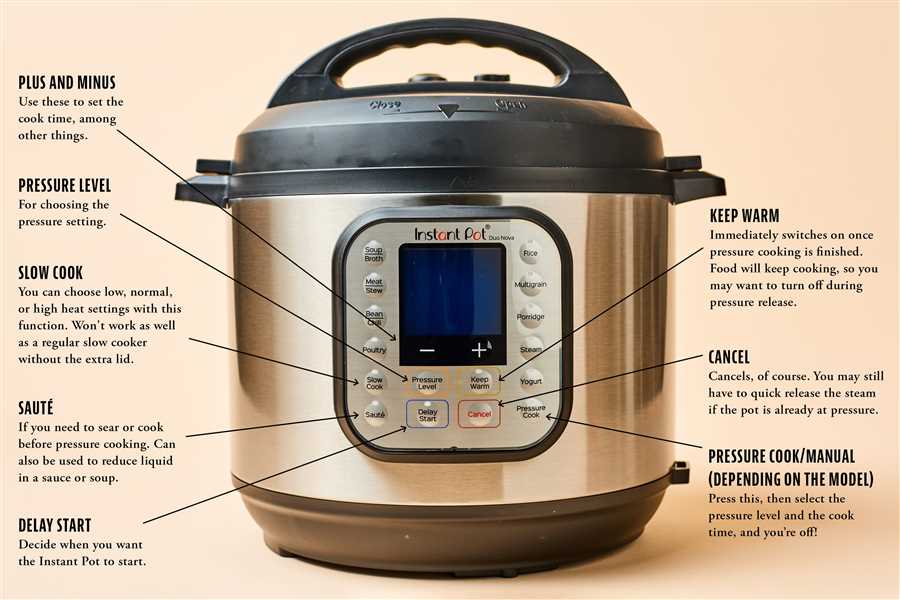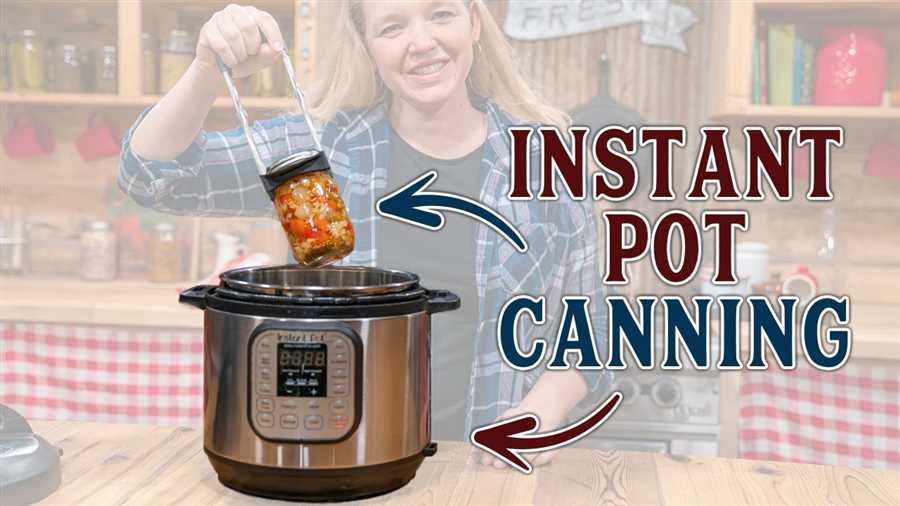When it comes to canning, many people wonder if they need a pressure cooker to safely preserve their food. The answer is, it depends on what you’re canning!
Pressure cookers are commonly used for canning low-acid foods, such as meat, poultry, and vegetables. These foods have a higher risk of containing harmful bacteria like Clostridium botulinum, which can cause botulism. Pressure canning is necessary to reach the high temperatures required to kill these bacteria and make the food safe to eat.
On the other hand, if you’re canning acidic foods like fruits, tomatoes, or pickles, a pressure cooker is not necessary. These foods have a naturally low pH level, which inhibits bacterial growth. Boiling water bath canning is sufficient to seal and preserve these types of foods.
In conclusion, whether you need a pressure cooker for canning depends on the type of food you plan to preserve. If you’re canning low-acid foods, it’s important to use a pressure cooker to ensure their safety. However, if you’re canning acidic foods, a boiling water bath canner is sufficient.
In any case, it’s crucial to follow proper canning techniques, including sterilizing jars, using high-quality ingredients, and processing the jars for the recommended amount of time. By doing so, you can enjoy the taste and nutritional benefits of home-canned food all year round!
Benefits of using a pressure cooker for canning
Using a pressure cooker for canning offers numerous benefits that make it a preferred method for preserving food. Here are some of the main advantages:
1. Faster cooking time
A pressure cooker can significantly reduce the cooking time required for canning. The high pressure and steam inside the cooker create a quick cooking environment, allowing you to process your canned goods in less time compared to traditional canning methods. This is particularly beneficial when you have a large batch of produce to preserve.
2. Retains nutrients

One of the biggest advantages of pressure cooker canning is that it helps to retain the nutrients in the food being preserved. The shorter cooking time and the sealed environment of the pressure cooker help to preserve the vitamins and minerals in the food, unlike boiling or water bath canning methods which can cause nutrient loss.
3. Kills microorganisms
Pressure canning is an essential method for safely preserving low-acid foods. The high temperature and pressure inside the cooker can kill harmful microorganisms that can cause foodborne illnesses. This makes pressure canning an effective way to ensure the safety of your canned goods.
4. Versatility
A pressure cooker can be used for various types of canning, including preserving fruits, vegetables, meats, and soups. This versatility allows you to expand your canning options and experiment with different recipes and flavors.
5. Requires less energy
Pressure cooking requires less energy compared to other canning methods. The shorter cooking time and the efficient heat distribution in a pressure cooker help to conserve energy and reduce your overall energy consumption.
In conclusion, using a pressure cooker for canning offers several benefits, including faster cooking time, nutrient retention, microorganism elimination, versatility, and energy efficiency. It is a reliable and effective method for preserving food that can make your canning process quicker and more efficient.
Alternative methods for canning without a pressure cooker
While a pressure cooker is a convenient and efficient tool for canning, there are alternative methods that can be used if you don’t have one. These methods may take longer or require more attention, but they can still help you safely preserve your food. Here are a few alternatives to consider:
Water bath canning
Water bath canning is a popular method for canning high-acid foods, such as fruits, jams, and pickles. It involves submerging jars of food in boiling water for a specified period of time to kill any bacteria or pathogens. While this method cannot be used for low-acid foods, it can be a great option if you’re looking to can jams or pickles.
Steam canning

Steam canning is a newer method that can be used for both high-acid and low-acid foods. It involves using a large pot with a tight-fitting lid and a rack that allows steam to circulate around the jars. The steam creates a high temperature, which helps kill any bacteria or pathogens. Steam canning is a good alternative if you don’t have a pressure cooker but still want to can a variety of foods.
When using alternative methods for canning, it’s important to follow proper guidelines and recipes to ensure the safety of your canned goods. Here are a few tips to keep in mind:
| 1. Use the right equipment | Make sure you have the necessary equipment, such as jars, lids, and a thermometer, to properly can your food. Using improper equipment can compromise the safety of your canned goods. |
| 2. Follow tested recipes | Only use recipes that have been tested and approved for canning. This ensures that the proper acidity level and processing time are used to prevent bacterial growth. |
| 3. Check for proper seal | After the jars have cooled, check the seals to make sure they are tight and secure. If a jar is not properly sealed, it should be refrigerated and consumed within a few days rather than stored long-term. |
While a pressure cooker is often the preferred method for canning, these alternative methods can still be effective ways to preserve your food. Just remember to follow safety guidelines and use proper recipes to ensure the best results.
Considerations when canning without a pressure cooker
While a pressure cooker is typically recommended for canning, it is possible to can without one. However, there are several important considerations to keep in mind when choosing this method.
1. Acidic Foods
When canning without a pressure cooker, it is important to focus on canning high-acid foods. This is because high-acid foods have a natural pH level that inhibits the growth of harmful bacteria. Examples of high-acid foods include fruits, tomatoes, and pickles. By canning these types of foods, you can significantly reduce the risk of spoilage or contamination.
2. Water Bath Canning
The most common method of canning without a pressure cooker is water bath canning. This method involves submerging the jars of food in boiling water for a specific amount of time. The heat from the boiling water effectively kills off any bacteria or spores, preventing spoilage. However, it is important to note that water bath canning is only suitable for high-acid foods due to its lower processing temperature. For low-acid foods, a pressure cooker is necessary to reach the higher temperature needed to kill off any potential harmful bacteria.
Here is a table summarizing the key differences between water bath canning and pressure canning:
| Method | Processing Temperature | Suitable Foods |
|---|---|---|
| Water Bath Canning | 212°F (100°C) | High-acid foods: fruits, tomatoes, pickles |
| Pressure Canning | Above 240°F (116°C) | Low-acid foods: vegetables, meats, seafood |
It is important to follow proper canning guidelines and recipes when canning without a pressure cooker to ensure the safety and shelf life of your canned goods. This includes using sterilized jars, proper sealing techniques, and carefully following the recommended processing times for the specific food you are canning.
Factors to Consider When Deciding Whether to Use a Pressure Cooker
There are several factors to consider when deciding whether to use a pressure cooker for canning:
- Inherent Safety: Pressure cookers can be dangerous if used improperly. They operate by building up steam and pressure, which can cause the release of hot steam or even an explosion if not handled correctly. It is important to follow the manufacturer’s instructions and take proper safety precautions when using a pressure cooker.
- Type of Food: Some foods, such as vegetables and meats, require pressure canning to ensure safe preservation. Pressure canning can kill bacteria, molds, and yeasts that can cause spoilage or foodborne illnesses. If you plan to can foods with low acidity levels, such as meats, soups, and vegetables, a pressure cooker may be necessary.
- Acidity Levels: Foods with high acidity levels, such as fruits and pickles, can typically be safely canned using a boiling water bath method rather than a pressure cooker. The high acidity levels in these foods create an inhospitable environment for most bacteria and molds. However, foods with lower acidity levels require the higher temperatures achieved through pressure canning to ensure their safety.
- Time and Convenience: Pressure canning can be a faster method for preserving food compared to other methods. It allows for higher temperatures, which speed up the canning process. If you are looking to save time and want a more efficient way to can your food, a pressure cooker may be a good option for you.
- Available Equipment: Pressure cookers can be a significant investment, especially if you do not already own one. Consider the cost of purchasing a pressure cooker and any necessary accessories, such as canning jars and lids, before deciding whether to use a pressure cooker for canning.
It is important to carefully evaluate these factors and determine what will work best for your specific canning needs. Whether you choose to use a pressure cooker or not, always follow safe canning practices and guidelines to ensure the preservation of your food.
Questions and answers
Is it necessary to use a pressure cooker for canning?
No, it is not necessary to use a pressure cooker for canning. There are other methods available, such as water bath canning, that can be used for preserving food.
What is the difference between pressure canning and water bath canning?
The main difference between pressure canning and water bath canning is the method of processing. Pressure canning uses high temperatures and pressure to kill bacteria and other microorganisms, making it suitable for low-acid foods. Water bath canning, on the other hand, uses boiling water to create a hot temperature that is sufficient for preserving high-acid foods.
Can I use a pressure cooker instead of a pressure canner for canning?
Yes, a pressure cooker can be used instead of a pressure canner for canning, as long as it meets certain requirements. The pressure cooker must be large enough to hold the jars, have a rack to keep the jars off the bottom, and be able to reach and maintain the required pressure and temperature for canning. It is important to consult the manufacturer’s instructions and guidelines for canning in a pressure cooker.
What are the advantages of using a pressure cooker for canning?
Using a pressure cooker for canning has several advantages. It allows for faster processing times, as the high pressure and temperature can quickly kill bacteria and other microorganisms. It also allows for the preservation of low-acid foods, which cannot be safely preserved using other methods, such as water bath canning. Additionally, pressure canning helps to retain the texture, flavor, and nutritional value of the food being preserved.
Can I can without a pressure cooker or a water bath canner?
Yes, it is possible to can without a pressure cooker or a water bath canner, but it is important to use alternative methods that can ensure the safety of the preserved food. Some alternatives include steam canning, oven canning, or using a boiling water method on stovetop. However, it is crucial to follow proper guidelines, recipes, and techniques to ensure that the canned food is safe to consume.






